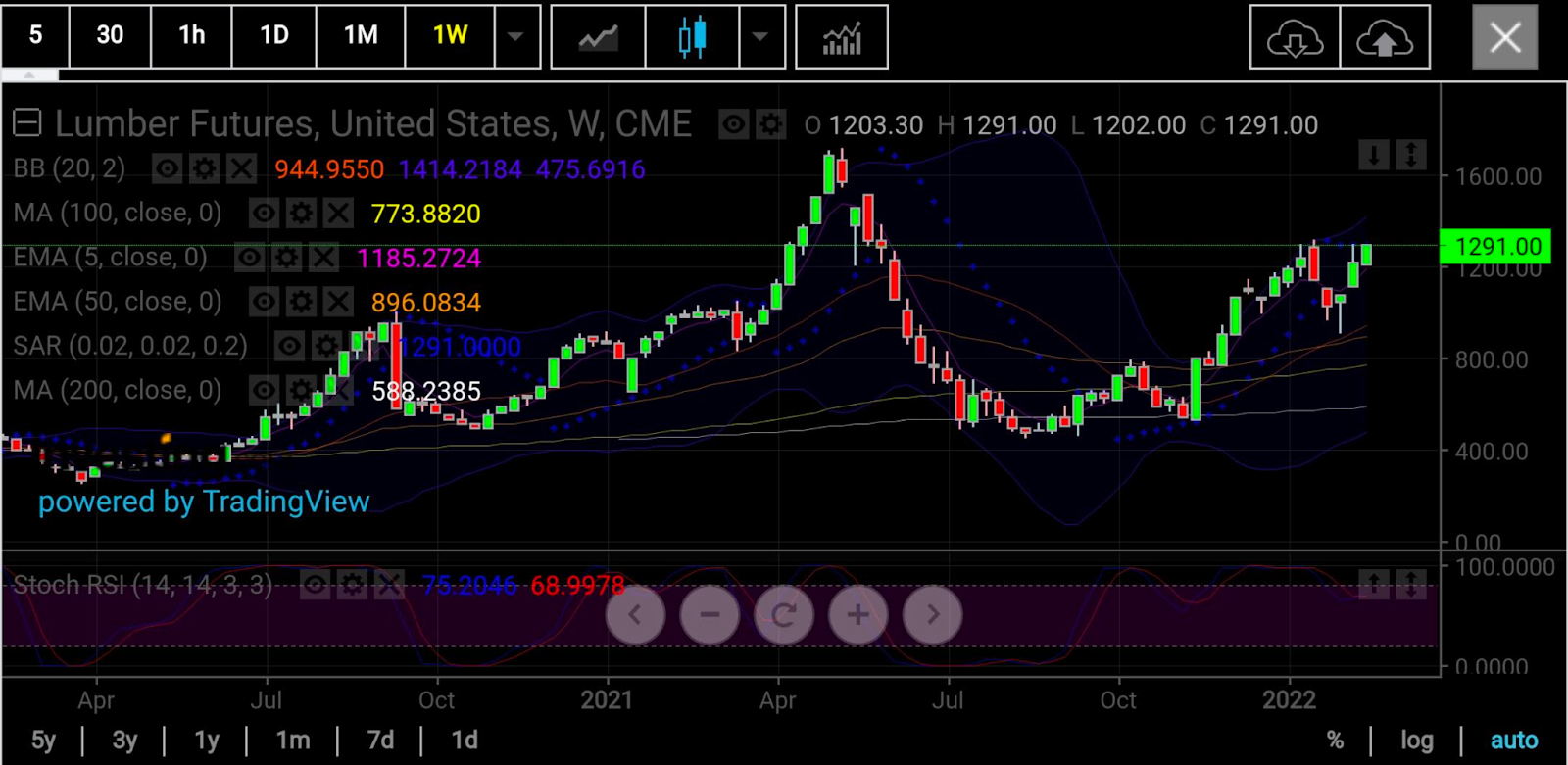Eight trading limit highs in nine days—lumber futures are literally going through the roof.
The No. 1 ingredient for US house building has resumed its rally after a one-month reprieve in January—rising 32% so far for February after back-to-back surges of 39% in November and December.
Lumber futures on the Chicago Mercantile Exchange have risen to the maximum $45 level permissible per day for nine of the past 10 sessions.

All charts courtesy of skcharting.com
At Tuesday’s settlement, the front-month March lumber contract on the exchange was at a three-week high of $1,291 per 1,000 board feet, from the Feb. 1 close of $934.90.
“Prices are well above trend pricing, as well as our own price forecasts,” Mark Wilde, an analyst at BMO Capital Markets in New York, was quoted saying by Bloomberg earlier this week.
“We are also just heading toward spring construction season and housing market activity, so it wouldn’t surprise me to see prices rally further.”
The impact of all this on house prices in the US cannot be understated.
Sales of new homes in the United States shot up by 12% in December from a month earlier as first-time buyers continued to flock to the property market ahead of an impending interest rate hike, Commerce Department data showed.
The median selling price for a new home in December was $377,700 while the average was $457,300. In November, the median was at $416,900 while the average was $481,700—both at a record high.
Dire housing shortages in the US since the financial crisis of 2007/2008 and the outbreak of the coronavirus have led to a scramble among first-time buyers, triggering record high prices.
To compound the problem, the Federal Reserve is expected to raise interest rates by as many as five to seven times this year to curb inflation growing at its fastest pace in four decades.
The US Consumer Price Index—a closely-watched inflation barometer—grew by 7.5% in the year to December, its fastest since 1982.
As Bloomberg noted, wood prices have been volatile since the pandemic began and they touched record highs during a COVID-fueled building boom, then collapsed because sawmills ramped up production and high prices stifled demand.
An index of the home framing composite has more than tripled since late August, adding to the cost of an average new home.

Still, lumber is about 30% below the record high of $1,711 reached in May 2021.
"I believe it's part of the larger move in commodities," David Russell, VP of market intelligence at online broker-dealer TradeStation, told Business Insider last week.
"We have a kind of a broad shift of money toward commodities and materials in the broader market."
Russell said commodity prices—including those for iron, oil, soybeans, and fertilizer—have mostly pointed higher amid cold winter weather, geopolitical tensions, and supply chain disruptions.
"Many of the same things that have caused lumber prices to rise over the last six months to a year are continuing to affect lumber prices today," Chip Setzer, director of trading and growth for Mickey Group, a commodity trading platform, told Insider.
"Demand for forest and lumber products remains high and supply continues to be limited."
Michael Goodman, director of specialty products at Sherwood Lumber, concurred.
"Between the combined extreme demand, weather, trucking, and other various supply chain issues, [lumber] continues to push the price to new highs," Goodman also told Insider.
"We are only in February and seeing record months in volume. Most anticipated a slowdown due to interest rates but the heavy grind continues and will continue for some time."
So, what do lumber futures’ charts say?
“The weekly chart set up is all bullish, with resumption of uptrend after prices gained support at $900,” said Sunil Kumar Dixit, chief technical strategist at skcharting.com.
“The rally is very likely to extend, to test $1,335.”
That’s not all. Strong buying above $1,335 will likely boost lumber to the next level of $1,540 to fill the runaway gap left in May 2021, added Dixit.
Disclaimer: Barani Krishnan uses a range of views outside his own to bring diversity to his analysis of any market. For neutrality, he sometimes presents contrarian views and market variables. He does not hold a position in the commodities and securities he writes about.
